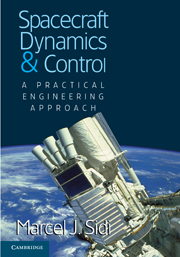Book contents
- Frontmatter
- Dedication
- Contents
- Preface
- Acknowledgments
- Chapter 1 Introduction
- Chapter 2 Orbit Dynamics
- Chapter 3 Orbital Maneuvers
- Chapter 4 Attitude Dynamics and Kinematics
- Chapter 5 Gravity Gradient Stabilization
- Chapter 6 Single- and Dual-Spin Stabilization
- Chapter 7 Attitude Maneuvers in Space
- Chapter 8 Momentum-Biased Attitude Stabilization
- Chapter 9 Reaction Thruster Attitude Control
- Chapter 10 Structural Dynamics and Liquid Sloshing
- Appendix A Attitude Transformations in Space
- Appendix B Attitude Determination Hardware
- Appendix C Orbit and Attitude Control Hardware
- Index
- References
Chapter 8 - Momentum-Biased Attitude Stabilization
Published online by Cambridge University Press: 18 December 2014
- Frontmatter
- Dedication
- Contents
- Preface
- Acknowledgments
- Chapter 1 Introduction
- Chapter 2 Orbit Dynamics
- Chapter 3 Orbital Maneuvers
- Chapter 4 Attitude Dynamics and Kinematics
- Chapter 5 Gravity Gradient Stabilization
- Chapter 6 Single- and Dual-Spin Stabilization
- Chapter 7 Attitude Maneuvers in Space
- Chapter 8 Momentum-Biased Attitude Stabilization
- Chapter 9 Reaction Thruster Attitude Control
- Chapter 10 Structural Dynamics and Liquid Sloshing
- Appendix A Attitude Transformations in Space
- Appendix B Attitude Determination Hardware
- Appendix C Orbit and Attitude Control Hardware
- Index
- References
Summary

- Type
- Chapter
- Information
- Spacecraft Dynamics and ControlA Practical Engineering Approach, pp. 210 - 259Publisher: Cambridge University PressPrint publication year: 1997
References
- 2
- Cited by

